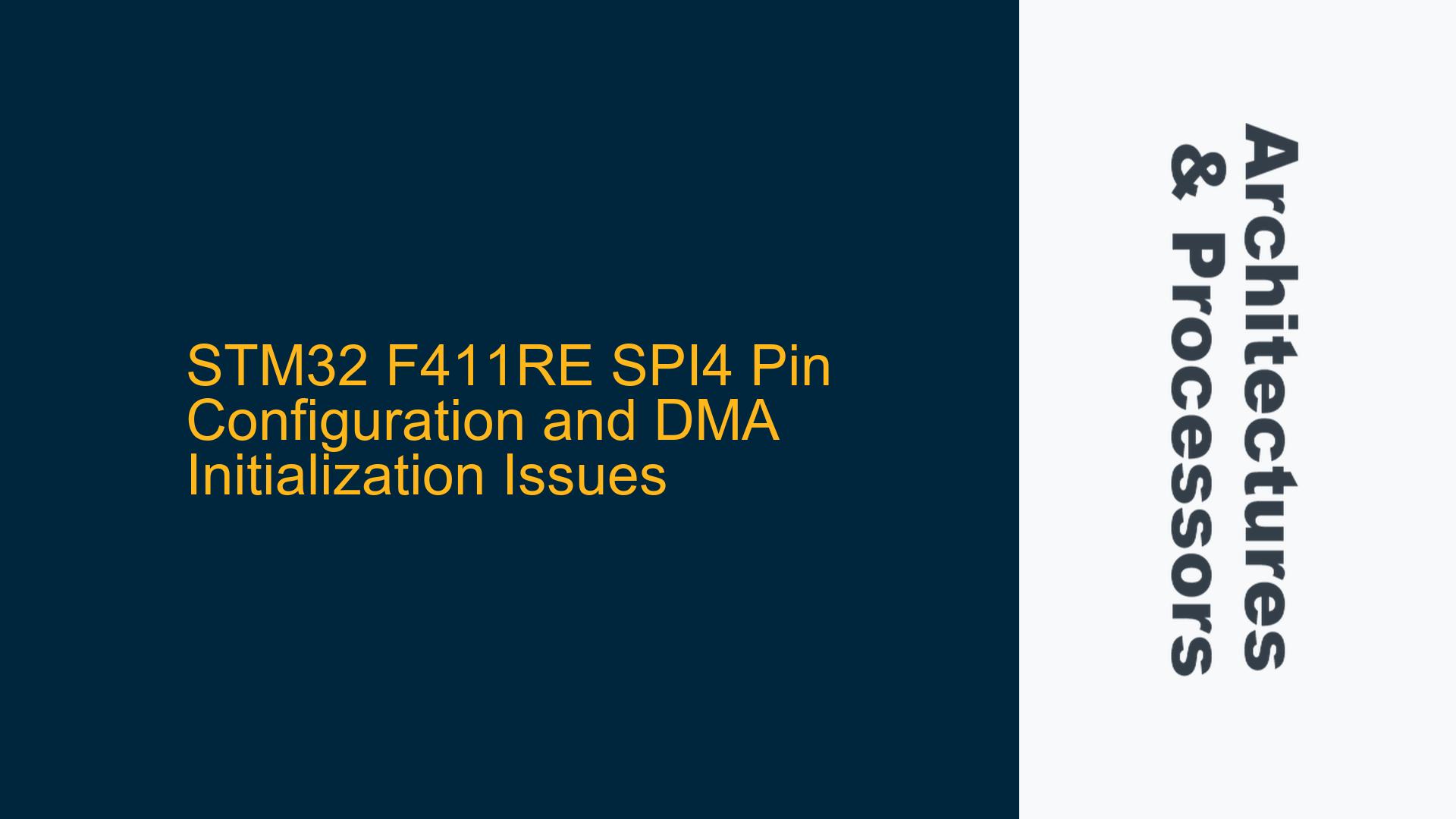SPI4 Pin Configuration and DMA Initialization Failures on STM32 F411RE
The STM32 F411RE microcontroller, based on the ARM Cortex-M4 architecture, is a powerful device widely used in embedded systems for its robust peripheral support, including multiple SPI interfaces. However, when transitioning from SPI1 to SPI4 on the STM32 F411RE Nucleo board, users often encounter issues where the SPI4 pins (CLK, MISO, MOSI) fail to exhibit any signal activity. This problem is particularly perplexing because the same code works flawlessly with SPI1. The root cause typically lies in subtle misconfigurations in the GPIO alternate function mappings, DMA stream assignments, or peripheral clock enablement. Below, we will dissect the issue, explore potential causes, and provide detailed troubleshooting steps to resolve the problem.
GPIO Alternate Function Mappings and Peripheral Clock Enablement
The STM32 F411RE microcontroller requires precise configuration of GPIO pins to function as SPI4 signals. Each SPI peripheral (SPI1, SPI2, SPI3, SPI4) is mapped to specific GPIO pins, and these pins must be configured with the correct alternate function (AF) to route the SPI signals correctly. Additionally, the peripheral clocks for both the GPIO ports and the SPI4 peripheral must be enabled.
GPIO Pin Configuration for SPI4
The SPI4 interface on the STM32 F411RE uses the following pins:
- SCK (Serial Clock): PB13 (Alternate Function AF6)
- MISO (Master In Slave Out): PA11 (Alternate Function AF6)
- MOSI (Master Out Slave In): PA1 (Alternate Function AF5)
The GPIO pins must be configured in alternate function mode, with the appropriate AF selected. For example, PB13 must be set to AF6 for SPI4_SCK, and PA11 must be set to AF6 for SPI4_MISO. PA1, however, uses AF5 for SPI4_MOSI, which is a common source of confusion. Incorrect AF selection will result in no signal activity on the pins.
Peripheral Clock Enablement
The STM32 F411RE uses the AHB1 bus for GPIO clocks and the APB2 bus for SPI4. The following clocks must be enabled:
- GPIOA and GPIOB clocks: Enabled via the AHB1 bus using
LL_AHB1_GRP1_EnableClock(LL_AHB1_GRP1_PERIPH_GPIOA)andLL_AHB1_GRP1_EnableClock(LL_AHB1_GRP1_PERIPH_GPIOB). - SPI4 clock: Enabled via the APB2 bus using
LL_APB2_GRP1_EnableClock(LL_APB2_GRP1_PERIPH_SPI4).
Failure to enable these clocks will result in the SPI4 peripheral and its associated GPIO pins being non-functional.
Common Mistakes
- Incorrect Alternate Function Selection: Using AF5 for SPI4_SCK or SPI4_MISO instead of AF6.
- Missing Clock Enablement: Forgetting to enable the GPIOA, GPIOB, or SPI4 clocks.
- Incorrect Pin Mapping: Using the wrong GPIO pins (e.g., PB12 instead of PB13 for SCK).
DMA Stream and Channel Configuration for SPI4
The STM32 F411RE uses DMA to handle high-speed data transfers for SPI communication. Each SPI peripheral has specific DMA streams and channels assigned for transmit (TX) and receive (RX) operations. For SPI4, the following DMA streams and channels are used:
- SPI4_RX: DMA2 Stream0, Channel 4
- SPI4_TX: DMA2 Stream1, Channel 4
DMA Configuration Steps
- Enable DMA2 Clock: The DMA2 controller must be enabled using
LL_AHB1_GRP1_EnableClock(LL_AHB1_GRP1_PERIPH_DMA2). - Configure NVIC for DMA Interrupts: The NVIC must be configured to handle DMA transfer complete and error interrupts for the appropriate streams (Stream0 and Stream1 for SPI4).
- Set Up DMA Streams: Each DMA stream must be configured with the correct direction, priority, mode, and data alignment. For example:
- SPI4_RX: Configured for peripheral-to-memory transfer with high priority, normal mode, and byte alignment.
- SPI4_TX: Configured for memory-to-peripheral transfer with high priority, normal mode, and byte alignment.
- Enable DMA Interrupts: Transfer complete (TC) and transfer error (TE) interrupts must be enabled for both RX and TX streams.
Common Mistakes
- Incorrect DMA Stream or Channel Selection: Using Stream2 and Stream3 (SPI1 defaults) instead of Stream0 and Stream1 for SPI4.
- Missing DMA Clock Enablement: Forgetting to enable the DMA2 clock.
- Incorrect Interrupt Configuration: Failing to configure NVIC for DMA2 Stream0 and Stream1 interrupts.
Implementing Correct GPIO and DMA Configurations for SPI4
To resolve the issue of SPI4 pins not working, follow these detailed steps to ensure correct GPIO and DMA configurations:
Step 1: Verify GPIO Pin Configuration
-
Check Alternate Function Mappings:
- Ensure PB13 is configured as AF6 for SPI4_SCK.
- Ensure PA11 is configured as AF6 for SPI4_MISO.
- Ensure PA1 is configured as AF5 for SPI4_MOSI.
- Use the following code snippet for GPIO configuration:
LL_GPIO_SetPinMode(GPIOB, LL_GPIO_PIN_13, LL_GPIO_MODE_ALTERNATE); LL_GPIO_SetAFPin_8_15(GPIOB, LL_GPIO_PIN_13, LL_GPIO_AF_6); LL_GPIO_SetPinSpeed(GPIOB, LL_GPIO_PIN_13, LL_GPIO_SPEED_FREQ_HIGH); LL_GPIO_SetPinPull(GPIOB, LL_GPIO_PIN_13, LL_GPIO_PULL_DOWN); LL_GPIO_SetPinMode(GPIOA, LL_GPIO_PIN_11, LL_GPIO_MODE_ALTERNATE); LL_GPIO_SetAFPin_8_15(GPIOA, LL_GPIO_PIN_11, LL_GPIO_AF_6); LL_GPIO_SetPinSpeed(GPIOA, LL_GPIO_PIN_11, LL_GPIO_SPEED_FREQ_HIGH); LL_GPIO_SetPinPull(GPIOA, LL_GPIO_PIN_11, LL_GPIO_PULL_DOWN); LL_GPIO_SetPinMode(GPIOA, LL_GPIO_PIN_1, LL_GPIO_MODE_ALTERNATE); LL_GPIO_SetAFPin_0_7(GPIOA, LL_GPIO_PIN_1, LL_GPIO_AF_5); LL_GPIO_SetPinSpeed(GPIOA, LL_GPIO_PIN_1, LL_GPIO_SPEED_FREQ_HIGH); LL_GPIO_SetPinPull(GPIOA, LL_GPIO_PIN_1, LL_GPIO_PULL_DOWN);
-
Enable GPIO Clocks:
- Ensure GPIOA and GPIOB clocks are enabled:
LL_AHB1_GRP1_EnableClock(LL_AHB1_GRP1_PERIPH_GPIOA); LL_AHB1_GRP1_EnableClock(LL_AHB1_GRP1_PERIPH_GPIOB);
- Ensure GPIOA and GPIOB clocks are enabled:
Step 2: Verify DMA Configuration
-
Enable DMA2 Clock:
- Ensure the DMA2 clock is enabled:
LL_AHB1_GRP1_EnableClock(LL_AHB1_GRP1_PERIPH_DMA2);
- Ensure the DMA2 clock is enabled:
-
Configure NVIC for DMA Interrupts:
- Set up NVIC for DMA2 Stream0 and Stream1:
NVIC_SetPriority(DMA2_Stream0_IRQn, 0); NVIC_EnableIRQ(DMA2_Stream0_IRQn); NVIC_SetPriority(DMA2_Stream1_IRQn, 0); NVIC_EnableIRQ(DMA2_Stream1_IRQn);
- Set up NVIC for DMA2 Stream0 and Stream1:
-
Configure DMA Streams:
- Set up DMA2 Stream0 for SPI4_RX and DMA2 Stream1 for SPI4_TX:
LL_DMA_ConfigTransfer(DMA2, LL_DMA_STREAM_0, LL_DMA_DIRECTION_PERIPH_TO_MEMORY | LL_DMA_PRIORITY_HIGH | LL_DMA_MODE_NORMAL | LL_DMA_PERIPH_NOINCREMENT | LL_DMA_MEMORY_INCREMENT | LL_DMA_PDATAALIGN_BYTE | LL_DMA_MDATAALIGN_BYTE); LL_DMA_ConfigAddresses(DMA2, LL_DMA_STREAM_0, LL_SPI_DMA_GetRegAddr(SPI4), (uint32_t)aRxBuffer, LL_DMA_GetDataTransferDirection(DMA2, LL_DMA_STREAM_0)); LL_DMA_SetDataLength(DMA2, LL_DMA_STREAM_0, ubNbDataToReceive); LL_DMA_SetChannelSelection(DMA2, LL_DMA_STREAM_0, LL_DMA_CHANNEL_4); LL_DMA_ConfigTransfer(DMA2, LL_DMA_STREAM_1, LL_DMA_DIRECTION_MEMORY_TO_PERIPH | LL_DMA_PRIORITY_HIGH | LL_DMA_MODE_NORMAL | LL_DMA_PERIPH_NOINCREMENT | LL_DMA_MEMORY_INCREMENT | LL_DMA_PDATAALIGN_BYTE | LL_DMA_MDATAALIGN_BYTE); LL_DMA_ConfigAddresses(DMA2, LL_DMA_STREAM_1, (uint32_t)aTxBuffer, LL_SPI_DMA_GetRegAddr(SPI4), LL_DMA_GetDataTransferDirection(DMA2, LL_DMA_STREAM_1)); LL_DMA_SetDataLength(DMA2, LL_DMA_STREAM_1, ubNbDataToTransmit); LL_DMA_SetChannelSelection(DMA2, LL_DMA_STREAM_1, LL_DMA_CHANNEL_4);
- Set up DMA2 Stream0 for SPI4_RX and DMA2 Stream1 for SPI4_TX:
-
Enable DMA Interrupts:
- Enable transfer complete and error interrupts for both streams:
LL_DMA_EnableIT_TC(DMA2, LL_DMA_STREAM_0); LL_DMA_EnableIT_TE(DMA2, LL_DMA_STREAM_0); LL_DMA_EnableIT_TC(DMA2, LL_DMA_STREAM_1); LL_DMA_EnableIT_TE(DMA2, LL_DMA_STREAM_1);
- Enable transfer complete and error interrupts for both streams:
Step 3: Verify SPI4 Peripheral Configuration
-
Enable SPI4 Clock:
- Ensure the SPI4 clock is enabled:
LL_APB2_GRP1_EnableClock(LL_APB2_GRP1_PERIPH_SPI4);
- Ensure the SPI4 clock is enabled:
-
Configure SPI4 Parameters:
- Set the baud rate, data width, clock polarity, and phase:
LL_SPI_SetBaudRatePrescaler(SPI4, LL_SPI_BAUDRATEPRESCALER_DIV8); LL_SPI_SetTransferDirection(SPI4, LL_SPI_FULL_DUPLEX); LL_SPI_SetClockPhase(SPI4, LL_SPI_PHASE_1EDGE); LL_SPI_SetClockPolarity(SPI4, LL_SPI_POLARITY_LOW); LL_SPI_SetTransferBitOrder(SPI4, LL_SPI_MSB_FIRST); LL_SPI_SetDataWidth(SPI4, LL_SPI_DATAWIDTH_8BIT); LL_SPI_SetNSSMode(SPI4, LL_SPI_NSS_SOFT);
- Set the baud rate, data width, clock polarity, and phase:
-
Enable DMA Requests:
- Enable DMA requests for RX and TX:
LL_SPI_EnableDMAReq_RX(SPI4); LL_SPI_EnableDMAReq_TX(SPI4);
- Enable DMA requests for RX and TX:
By meticulously following these steps, you can resolve the issue of SPI4 pins not working on the STM32 F411RE. The key lies in ensuring correct GPIO alternate function mappings, proper DMA stream and channel assignments, and accurate peripheral clock enablement. Once these configurations are verified, the SPI4 interface should function as expected, enabling seamless communication with external devices.






